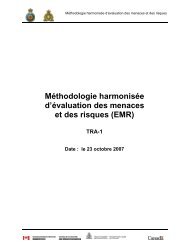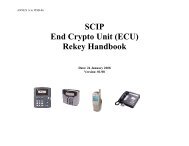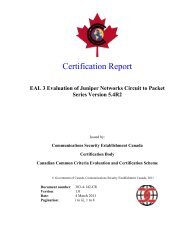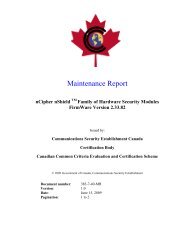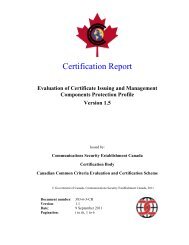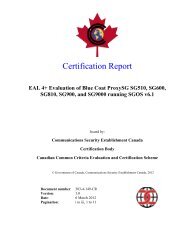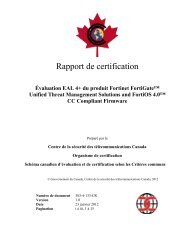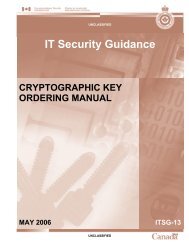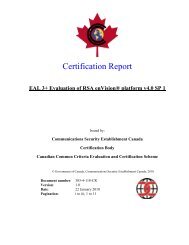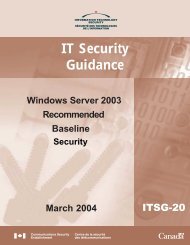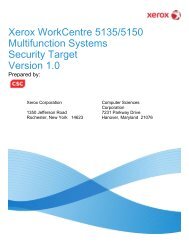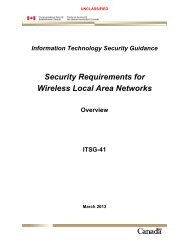Conseils sur l'utilisation du protocole TLS - Centre de la sécurité des ...
Conseils sur l'utilisation du protocole TLS - Centre de la sécurité des ...
Conseils sur l'utilisation du protocole TLS - Centre de la sécurité des ...
You also want an ePaper? Increase the reach of your titles
YUMPU automatically turns print PDFs into web optimized ePapers that Google loves.
November 2008 ITSB-60 novembre 2008<br />
cryptographic primitives in the cipher suite<br />
which shall not be used for the protection of<br />
Protected A and B information: Kerberos, RC2,<br />
RC4, IDEA, DES, Camellia, MD2, MD4, and<br />
MD5. CSEC recommends that any <strong>TLS</strong> client<br />
that supports these protocols and algorithms be<br />
disabled.<br />
The NULL parameter shall not be used for any<br />
cryptographic primitive.<br />
générateurs <strong>de</strong> bits aléatoires approuvés sont précisés<br />
dans l’ITSA-11d.<br />
La norme <strong>TLS</strong> incorpore les primitives<br />
cryptographiques suivantes dans <strong>la</strong> suite <strong>de</strong> chiffres<br />
qui ne doivent pas être utilisées pour <strong>la</strong> protection <strong>de</strong>s<br />
renseignements PROTÉGÉ A et PROTÉGÉ B :<br />
Kerberos, RC2, RC4, IDEA, DES, Camellia, MD2,<br />
MD4 et MD5. Le CSTC recomman<strong>de</strong> <strong>de</strong> désactiver<br />
tout client <strong>TLS</strong> qui peut prendre en charge ces<br />
algorithmes et <strong>protocole</strong>s.<br />
Le paramètre NULL ne doit être utilisé pour aucune<br />
primitive cryptographique.<br />
Table 1 : Approved Cryptographic Primitives for <strong>TLS</strong>/<br />
Tableau 1 : Primitives cryptographiques approuvées pour le <strong>protocole</strong> <strong>TLS</strong><br />
Key<br />
Establishment/<br />
Établissement<br />
<strong>de</strong> clés<br />
RSA<br />
Block<br />
Ciphers/<br />
Chiffrement<br />
par bloc<br />
AES<br />
Hash<br />
Functions/<br />
Fonctions<br />
<strong>de</strong> hachage<br />
SHA-1<br />
Digital<br />
Signatures/<br />
Signatures<br />
numériques<br />
DSA<br />
Random Bit Generation/<br />
Génération <strong>de</strong> bits<br />
aléatoires<br />
Hash_DRBG<br />
Integrity<br />
Protection/<br />
Protection<br />
<strong>de</strong> l’intégrité<br />
HMAC<br />
Diffie-Hellman<br />
Triple DES<br />
SHA-224<br />
RSA<br />
HMAC_DRBG<br />
CMAC<br />
Key Exchange<br />
Algorithm (KEA)<br />
Elliptic Curve<br />
Diffie-Hellman<br />
Elliptic Curve<br />
MQV<br />
CAST5<br />
SKIPJACK<br />
SHA-256<br />
SHA-384<br />
SHA-512<br />
Elliptic Curve<br />
DSA<br />
CTR_DRBG<br />
Dual_EC_DRBG<br />
Legacy DRBGs based on DES,<br />
Triple DES, AES, SHA-1, and<br />
HMAC /<br />
Anciens générateurs <strong>de</strong> bits<br />
aléatoires déterministes fondés<br />
<strong>sur</strong> DES, Triple DES, AES,<br />
SHA-1, et HMAC.<br />
References<br />
There are numerous standards and NIST<br />
Special Publications which <strong>de</strong>fine the<br />
cryptographic primitives used in this Bulletin<br />
as well as documents to provi<strong>de</strong> guidance on<br />
security parameters.<br />
Références<br />
Il existe <strong>de</strong> nombreuses normes et publications<br />
spéciales <strong>du</strong> NIST qui définissent officiellement les<br />
primitives cryptographiques utilisées dans le présent<br />
bulletin, <strong>de</strong> même que <strong>de</strong>s documents offrant <strong>de</strong>s<br />
conseils <strong>sur</strong> les paramètres <strong>de</strong> sécurité.<br />
6



